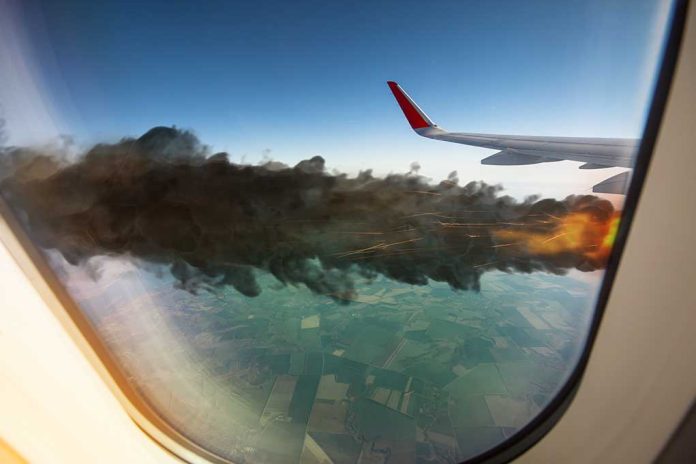
Flames and smoke erupted from an American Airlines aircraft engine mid-flight, forcing an emergency landing in Las Vegas with 165 anxious passengers on board, all of whom walked away without injury.
Key Takeaways
- American Airlines Flight 1665 made an emergency landing in Las Vegas after one of its engines began emitting sparks and smoke shortly after takeoff
- The Airbus A321 with 153 passengers and 6 crew members landed safely at Harry Reid International Airport with no injuries reported
- Multiple videos captured the alarming sight of smoke trailing from the engine as the plane circled back to the airport
- The aircraft was removed from service for maintenance assessment, though preliminary inspections found no evidence of actual fire in the engine
- A recovery flight was scheduled to depart Las Vegas for Charlotte on June 26
Engine Malfunction Forces Emergency Procedures
American Airlines Flight 1665 experienced a serious engine malfunction on Wednesday, June 25, 2025, just moments after taking off from Harry Reid International Airport in Las Vegas. The Airbus A321, bound for Charlotte, North Carolina, began emitting sparks and smoke from one of its engines at approximately 8:11 a.m. local time. The dramatic incident, captured on video by numerous witnesses, showed dark smoke trailing behind the aircraft as it circled back toward the airport, creating moments of intense concern for those watching from the ground and the 153 passengers and 6 crew members aboard the flight.
The flight crew immediately implemented emergency procedures upon detecting the engine issue, coordinating with air traffic control to execute a priority return to Las Vegas. The swift response highlighted the importance of proper training and emergency protocols in aviation safety,” according to FAA officials, the engine began smoking just moments after takeoff, requiring immediate action from the flight crew to ensure passenger safety and prevent any potential escalation of the mechanical problem.
Professional Crew Response Ensures Safe Return
The American Airlines crew demonstrated exemplary professionalism during the emergency, safely navigating the aircraft back to Harry Reid International Airport despite the concerning engine condition. The flight landed safely at approximately 8:20 a.m., just nine minutes after departure. After touching down without incident, the aircraft was able to taxi to the gate under its own power, allowing passengers to disembark normally through regular boarding procedures rather than requiring emergency evacuation equipment, further evidence of the controlled management of the situation.
“The flight departed LAS and returned, landing safely and there were no reported injuries,” stated a Las Vegas airport spokesperson.
American Airlines praised the response of their team members during the incident, stating, “We appreciate the professionalism of our crew and thank our team who are working to get our customers to their destinations as quickly as possible.” This acknowledgment underscores the critical role that well-trained flight crews play in managing in-flight emergencies and ensuring passenger safety remains the highest priority even during mechanical failures.
Aircraft Maintenance and Passenger Accommodations
Following the incident, American Airlines immediately removed the Airbus A321 aircraft from service to undergo comprehensive maintenance assessment. Initial inspections found no evidence of actual fire in the engine despite the dramatic appearance of flames and smoke visible in witness videos. This discrepancy highlights the sometimes misleading nature of in-flight mechanical issues, where exhaust emissions can appear more catastrophic than the underlying mechanical problem. The airline’s maintenance team will conduct thorough examinations to determine the exact cause of the engine malfunction.
“The aircraft taxied to the gate under its own power and customers deplaned normally,” stated American Airlines, in their official response to the incident.
To accommodate the disrupted passengers, American Airlines scheduled a recovery flight to depart from Las Vegas to Charlotte on June 26 at 1:00 p.m., allowing travelers to continue their journeys with minimal delay. This prompt rescheduling demonstrates the airline’s commitment to passenger service even during unexpected operational challenges. The airline’s emergency response procedures appeared to function effectively, from the immediate in-flight decisions to the post-incident passenger accommodations and aircraft evaluation.





